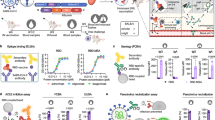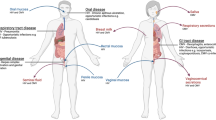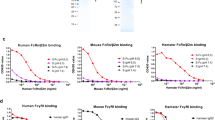Abstract
Almost all infectious diseases are initiated at mucosal surfaces, yet intramuscular or subcutaneous vaccination usually provides only minimal protection at sites of infection owing to suboptimal activation of the mucosal immune system. The neonatal Fc receptor (FcRn) mediates the transport of IgG across polarized epithelial cells lining mucosal surfaces. We mimicked this process by fusing a model antigen, herpes simplex virus type-2 (HSV-2) glycoprotein gD, to an IgG Fc fragment. Intranasal immunization, together with the adjuvant CpG, completely protected wild-type, but not FcRn knockout, mice after intravaginal challenge with virulent HSV-2 186. This immunization strategy induced efficient mucosal and systemic antibody, B- and T-cell immune responses, with stable protection for at least 6 months after vaccination in most of the immunized animals. The FcRn-IgG transcellular transport pathway may provide a general delivery route for subunit vaccines against many mucosal pathogens.
This is a preview of subscription content, access via your institution
Access options
Subscribe to this journal
Receive 12 print issues and online access
$259.00 per year
only $21.58 per issue
Buy this article
- Purchase on SpringerLink
- Instant access to full article PDF
Prices may be subject to local taxes which are calculated during checkout




Similar content being viewed by others
References
Neutra, M.R. & Kozlowski, P.A. Mucosal vaccines: the promise and the challenge. Nat. Rev. Immunol. 6, 148–158 (2006).
Holmgren, J. & Czerkinsky, C. Mucosal immunity and vaccines. Nat. Med. 11 Suppl S45–S53 (2005).
McGhee, J.R. et al. The mucosal immune system: from fundamental concepts to vaccine development. Vaccine 10, 75–88 (1992).
Gallichan, W.S. & Rosenthal, K.L. Long-term immunity and protection against herpes simplex virus type 2 in the murine female genital tract after mucosal but not systemic immunization. J. Infect. Dis. 177, 1155–1161 (1998).
Neutra, M.R., Mantis, N.J. & Kraehenbuhl, J.-P. Collaboration of epithelial cells with organized mucosal lymphoid tissues. Nat. Immunol. 2, 1004–1009 (2001).
Nochi, T. et al. A novel M cell-specific carbohydrate-targeted mucosal vaccine effectively induces antigen-specific immune responses. J. Exp. Med. 204, 2789–2796 (2007).
Ghetie, V. & Ward, E.S. Multiple roles for the major histocompatibility complex class I-related receptor FcRn. Annu. Rev. Immunol. 18, 739–766 (2000).
He, W. et al. FcRn-mediated antibody transport across epithelial cells revealed by electron tomography. Nature 455, 542–546 (2008).
Dickinson, B.L. et al. Bidirectional FcRn-dependent IgG transport in a polarized human intestinal epithelial cell line. J. Clin. Invest. 104, 903–911 (1999).
Roopenian, D.C. & Akilesh, S. FcRn: the neonatal Fc receptor comes of age. Nat. Rev. Immunol. 7, 715–725 (2007).
Baker, K. et al. Immune and non-immune functions of the (not so) neonatal Fc receptor, FcRn. Semin. Immunopathol. 31, 223–236 (2009).
Yoshida, M. et al. Neonatal Fc receptor for IgG regulates mucosal immune responses to luminal bacteria. J. Clin. Invest. 116, 2142–2151 (2006).
Kim, J.K., Tsen, M.F., Ghetie, V. & Ward, E.S. Localization of the site of the murine IgG1 molecule that is involved in binding to the murine intestinal Fc receptor. Eur. J. Immunol. 24, 2429–2434 (1994).
Duncan, A.R. & Winter, G. The binding site for C1q on IgG. Nature 332, 738–740 (1988).
McCarthy, K.M., Yoong, Y. & Simister, N.E. Bidirectional transcytosis of IgG by the rat neonatal Fc receptor expressed in a rat kidney cell line: a system to study protein transport across epithelia. J. Cell Sci. 113, 1277–1285 (2000).
Roopenian, D.C. et al. The MHC class I-like IgG receptor controls perinatal IgG transport, IgG homeostasis, and fate of IgG-Fc-coupled drugs. J. Immunol. 170, 3528–3533 (2003).
van Duin, D., Medzhitov, R. & Shaw, A.C. Triggering TLR signaling in vaccination. Trends Immunol. 27, 49–55 (2006).
Wolf, A.J. et al. Initiation of the adaptive immune response to Mycobacterium tuberculosis depends on antigen production in the local lymph node, not the lungs. J. Exp. Med. 205, 105–115 (2008).
Moyron-Quiroz, J.E. et al. Role of inducible bronchus associated lymphoid tissue (iBALT) in respiratory immunity. Nat. Med. 10, 927–934 (2004).
Parr, E.L. & Parr, M.B. Immunoglobulin G is the main protective antibody in mouse vaginal secretions after vaginal immunization with attenuated herpes simplex virus type 2. J. Virol. 71, 8109–8115 (1997).
Milligan, G.N., Dudley-McClain, K.L., Chu, C.F. & Young, C.G. Efficacy of genital T cell responses to herpes simplex virus type 2 resulting from immunization of the nasal mucosa. Virology 318, 507–515 (2004).
Ahmed, R. & Gray, D. Immunological memory and protective immunity: understanding their relation. Science 272, 54–60 (1996).
Bernasconi, N.L., Traggiai, E. & Lanzavecchia, A. Maintenance of serological memory by polyclonal activation of human memory B cells. Science 298, 2199–2202 (2002).
Dooms, H., Wolslegel, K., Lin, P. & Abbas, A.K. Interleukin-2 enhances CD4+ T cell memory by promoting the generation of IL-7Rα–expressing cells. J. Exp. Med. 204, 547–557 (2007).
Mi, W. et al. Targeting the neonatal Fc receptor for antigen delivery using engineered Fc fragments. J. Immunol. 181, 7550–7561 (2008).
Rawool, D.B. et al. Utilization of Fc receptors as a mucosal vaccine strategy against an intracellular bacterium, Francisella tularensis. J. Immunol. 180, 5548–5557 (2008).
Gallichan, W.S. et al. Intranasal immunization with CpG oligodeoxynucleotides as an adjuvant dramatically increases IgA and protection against herpes simplex virus-2 in the genital tract. J. Immunol. 166, 3451–3457 (2001).
Kwant, A. & Rosenthal, K.L. Intravaginal immunization with viral subunit protein plus CpG oligodeoxynucleotides induces protective immunity against HSV-2. Vaccine 22, 3098–3104 (2004).
Tengvall, S., Lundqvist, A., Eisenberg, R.J., Cohen, G.H. & Harandi, A.M. Mucosal administration of CpG oligodeoxynucleotide elicits strong CC and CXC chemokine responses in the vagina and serves as a potent Th1-tilting adjuvant for recombinant gD2 protein vaccination against genital herpes. J. Virol. 80, 5283–5291 (2006).
Lindqvist, M., Persson, J., Thörn, K. & Harandi, A.M. The mucosal adjuvant effect of alpha-galactosylceramide for induction of protective immunity to sexually transmitted viral infection. J. Immunol. 182, 6435–6443 (2009).
ChangLai, S.P., Hung, W.T. & Liao, K.K. Detecting alveolar epithelial injury following volatile anesthetics by (99m)Tc DTPA radioaerosol inhalation lung scan. Respiration 66, 506–510 (1999).
Lin, H. et al. Enhancing effect of surfactants on fexofenadine.HCl transport across the human nasal epithelial cell monolayer. Int. J. Pharm. 330, 23–31 (2007).
Kodama, S., Abe, N., Hirano, T. & Suzuki, M. Safety and efficacy of nasal application of CpG oligodeoxynucleotide as a mucosal adjuvant. Laryngoscope 116, 331–335 (2006).
Kelsall, B.L. & Rescigno, M. Mucosal dendritic cells in immunity and inflammation. Nat. Immunol. 5, 1091–1095 (2004).
Yoshida, M. et al. Human neonatal Fc receptor mediates transport of IgG into luminal secretions for delivery of antigens to mucosal dendritic cells. Immunity 20, 769–783 (2004).
Liu, X. et al. Activation of the JAK/STAT-1 signaling pathway by IFN-gamma can down-regulate functional expression of the MHC class I-related neonatal Fc receptor for IgG. J. Immunol. 181, 449–463 (2008).
Mestecky, J., Russell, J.N.W. & Elson, C.O. Perspectives on mucosal vaccines: is mucosal tolerance a barrier? J. Immunol. 179, 5633–5638 (2007).
Milligan, G.N., Bernstein, D.I. & Bourne, N. T lymphocytes are required for protection of the vaginal mucosae and sensory ganglia of immune mice against reinfection with herpes simplex virus type 2. J. Immunol. 160, 6093–6100 (1998).
Van den Broeck, W., Derore, A. & Simoens, P. Anatomy and nomenclature of murine lymph nodes: descriptive study and nomenclatory standardization in BALB/cAnNCrl mice. J. Immunol. Methods 312, 12–19 (2006).
Ye, L. et al. The MHC class II-associated invariant chain interacts with the neonatal Fc gamma receptor and modulates its trafficking to endosomal/lysosomal compartments. J. Immunol. 181, 2572–2585 (2008).
Acknowledgements
We thank K. Rosenthal and A. Harandi for their discussions of mucosal antigen transport and immunization. We thank G.J. Letchworth for helpful discussions and critical reading of the manuscript. We are grateful to N.E. Simister, Brandeis University, for supplying us with inner medullary collecting duct–FcRn cell line. We acknowledge the receipt of HSV-2 186 strain from L.R. Stanberry, Columbia University, and HSV gD plasmids from P. Spear, Northwestern University. We also acknowledge the helpful discussions with D. Mosser, D. Perez, S. Samal and W. Song. We are most grateful for the technical help from Y. Wang, L. Lu, X. Liu, S. Palaniyandi and Z. Li. This work was supported in part by the National Institutes of Health grants AI65892, AI67965, AI73139 (to X.Z.), DK56597 (to D.C.R.) and MAES competitive grants from the University of Maryland (to X.Z.).
Author information
Authors and Affiliations
Contributions
L.Y. and X.Z. designed and performed experiments, analyzed data and wrote the paper. R.Z. and Y.B. conducted experiments. D.C.R. interpreted data and made editorial suggestions.
Corresponding author
Ethics declarations
Competing interests
The authors declare no competing financial interests.
Supplementary information
Supplementary Text and Figures
Supplementary Figs. 1–10 (PDF 1054 kb)
Rights and permissions
About this article
Cite this article
Ye, L., Zeng, R., Bai, Y. et al. Efficient mucosal vaccination mediated by the neonatal Fc receptor. Nat Biotechnol 29, 158–163 (2011). https://doi.org/10.1038/nbt.1742
Received:
Accepted:
Published:
Issue date:
DOI: https://doi.org/10.1038/nbt.1742
This article is cited by
-
Current Progress and Challenges in the Study of Adjuvants for Oral Vaccines
BioDrugs (2023)
-
Delivery of Fc-fusion Protein by a Recombinant Newcastle Disease Virus Vector
Applied Biochemistry and Biotechnology (2023)
-
Albumin fusion with granulocyte-macrophage colony-stimulating factor acts as an immunotherapy against chronic tuberculosis
Cellular & Molecular Immunology (2021)
-
Assessments of different inactivating reagents in formulating transmissible gastroenteritis virus vaccine
Virology Journal (2020)
-
Generation of oligomers of subunit vaccine candidate glycoprotein D of Herpes Simplex Virus-2 expressed in fusion with IgM Fc domain(s) in Escherichia coli: A strategy to enhance the immunogenicity of the antigen
3 Biotech (2020)



